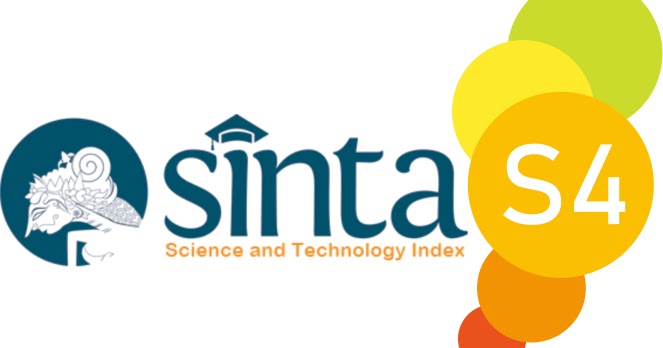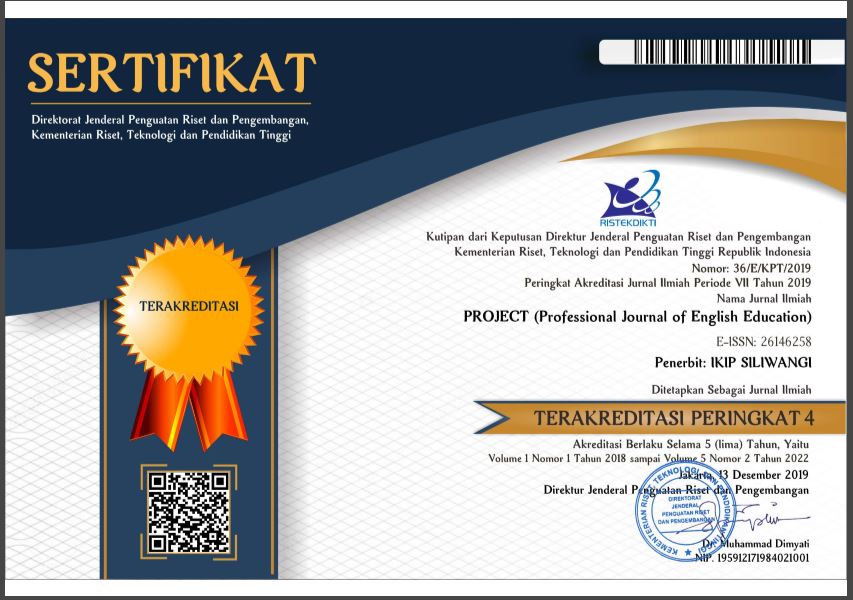Students’ Responses in Learning Listening Using Travel Vlog
Abstract
The use of ICT in daily life is familiar to the students because they can access it easily. One of media that can attract the students is travel vlog. Travel vlog is authentic media that influence the students’ learning experiences and outcomes in language classroom. This study raised the case regarding the students’ responses to learning listening skills through the use of travel vlog. This study used a descriptive quantitative method as it allows the researcher to find the percentage of the result. The participants were tenth grade students from class X-4 from one of senior high school in Cimahi, which consisted of 34 students. The data was carried out by research questionnaires consisting of 16 close-ended questions, which were analyzed using a Likert scale. This research has been done by distributing questionnaire in form google form to the students after they learned listening recount text using travel vlog in the classroom. This research found that travel vlog can be used as learning media in learning listening, as demonstrated by the result of the questionnaire. Finding indicates that the students generally perceive travel vlog positively, citing convenience in access and use, listening learning benefit, enhance the students’ motivation, and provide students’ enjoyment . It can be concluded that integrating travel vlogs into language learning can enhance the students’ excitement and motivation in learning listening.
References
Afrizal, & Herlina, R. (2023). Students’ Experiences on Learning Listening Through YouTube Media. JEEP: Journal of English Education Program, 10(1), 25–34. https://jurnal.unigal.ac.id/jeep/article/download/9682/pdf#:~:text=The findings showed that learning,after learning listening through Youtube.
Aran, O., Biel, J.-I., & Daniel, G.-P. (2014). Broadcasting Oneself: Visual Discovery of Vlogging Styles. IEEE Transactuions on Multimedia, 16(1), 201–215. https://doi.org/10.1109/TMM.2013.2284893
Boltiziar, J., & Munkova, D. (2023). Emergency remote teaching of listening comprehension using YouTube videos with captions. Education and Information Technologies. https://doi.org/10.1007/s10639-023-12282-7
Boudreau, C., MacIntyre, P. D., & Dewaele, J.-M. (2018). Enjoyment and anxiety in second language communication: An idiodynamic approach. Studies in Second Language Learning and Teaching, 8(1), 149–170. https://doi.org/10.14746/ssllt.2018.8.1.7
Deci, E. L., & Ryan, R. M. (2000). The “What” and “Why” of Goal Pursuits: Human Needs and the Self-Determination of Behavior. Psychological Inquiry, 11(4), 227–268. https://doi.org/10.1207/S15327965PLI1104_01
DeVito, J. A. (2000). Human Communication: The Basic Course. Longman.
Fredrickson, B. L. (2001). The role of positive emotions in positive psychology: The broaden-and-build theory of positive emotions. American Psychologist, 56(3), 218–226. https://doi.org/10.1037/0003-066X.56.3.218
İnce, H. G. (2015). EFL Learners’ Perceptions of Educational Podcasting. June. http://repository.bilkent.edu.tr/handle/11693/29145#.YGcanNHis7M.mendeley
Khoiriyah, A., Ramasari, M., & Syaprizal, S. (2023). Teaching Listening Skill by Using Video (Audio-Visual) to the Eleventh Grade Students at SMA Al-Ikhlas Lubuklinggau. Journal of English Education, Literature and Linguistics, 6(1), 32–43. https://doi.org/10.31540/jeell.v6i1.2478
Kim, H.-S. (2015). Using Authentic Videos to Improve EFL Students’ Listening Comprehension. International Journal of Contents, 11(4), 15–24. https://doi.org/10.5392/IJoC.2015.11.4.015
Lestari, J. A. (2019). The Use of Youtube Vlog to Improve The Students’ Listening Skill of MTs Samarinda. Tarbiyah Wa Ta’lim: Jurnal Penelitian Pendidikan Dan Pembelajaran, 6(1), 35–45. https://doi.org/10.21093/twt.v6i1.2041
Maya, Sudarsono, S., Ikhsanudin, Susilawati, E., & Salam, U. (2023). The Effect of Using Video to Enhance Listening Ability. Journal of Scientific Research, Education, and Technology (JSRET), 2(3), 1480–1488. https://doi.org/10.58526/jsret.v2i3.246
Meldayanti. (2022). The Influence of Youtube Videos on Listening Achievement of The Second-Grade Students At MA Guppi. English Language Teaching for EFL Learners, 4(1), 25–34. https://doi.org/10.24252/elties.v4i1.25074
Nunan, D. (2003). Listening in a second language. The English Centre, University of Hong Kong.
Nurhayani. (2019). Factors Affecting Students’ Listening Skill. Progress in Retinal and Eye Research, 561(April), 33–35.
Rufino, G. G. (2024). Methods Used in YouTube for Teaching and Learning English Language: A Systematic Literature Review. International Journal of English Language Studies, 6(1), 82–97. https://doi.org/10.32996/ijels.2024.6.1.9
Saricoban, A. (1999). The Teaching of Listening. The Internet TESL Journal Archives, V(No. 12). http://iteslj.org/Articles/Saricoban-Listening
Sugiyono. (2017). Metode Penelitian Kuantitatif, Kualitatif, dan R&D. Alfabeta.
Tang, S., Long, M., Tong, F., Wang, Z., Zhang, H., & Sutton-Jones, K. (2020). A Comparative Study of Problem-Based Learning and Traditional Approaches in College Englis Classroom: Analyzing Pedagogical Behaviors Via Classroom Observation. Behavioral Science, 10. https://doi.org/10.3390/bs10060105
Telaumbanua, Y., Satopramono, H., & Yalmiadi. (2022). “Youtube Go”: Developing EFL Learners’ Listening Skills and Social Learning Process. International Journal of English and Applied Linguistics, 2(1). https://doi.org/10.47709/ijeal.v2i1.1329
Vandergrift, L., & Goh, C. (2009). Teaching and Testing Listening Comprehension. In The Handbook of Language Teaching (pp. 395–411). Wiley. https://doi.org/10.1002/9781444315783.ch22
Yuyun, I., & Simamora, F. Y. (2021). the Use of Youtube To Support Efl Students’ Listening Skills. ELLTER Journal, 2(2), 1–12. https://doi.org/10.22236/ellter.v2i2.7512
Downloads
Published
Issue
Section
License

This work is licensed under a Creative Commons Attribution-ShareAlike 4.0 International License.




